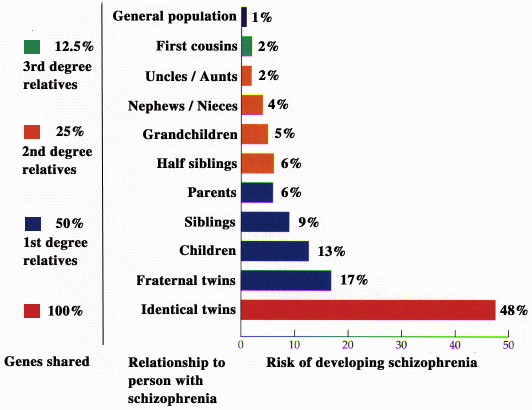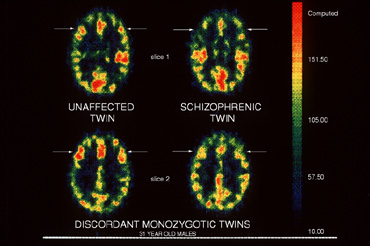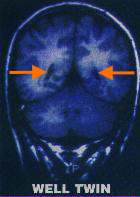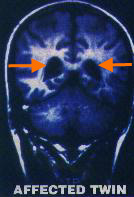
Heredity and the Genetics of Schizophrenia
From http://www-viz.tamu.edu/students/lynette/FRAME_HP/RISK/genetics.html#risk

Family statistics
As can be seen from
the graph below, schizophrenia definitely has a genetic component. Those who
have a third degree relative with schizophrenia are twice as likely to develop
schizophrenia as those in the general population. Those with a second degree
relative have a several-fold higher incidence of schizophrenia than the general
population, and first degree relatives have an incidence of schizophrenia an
order of magnitude higher than the general populace.
It is of much interest, though, that the correlation of schizophrenia between identical twins, who have identical genomes, is less than one-half. This indicates that schizophrenia is NOT entirely a genetic disease.
The current belief is that there are several genes that contribute to susceptibility or pathology of schizophrenia, but none exhibit full penetrance or a Mendelian pattern of inheritance. It is believed that schizophrenia is much like cancer, which is caused by a number of genetic and environmental factors. More information on the genetics of schizophrenia is given below.


 The image to the left shows an MRI image of unaffected and
schizophrenic identical twins. The brain structure pointed out is the
hippocampus.
The image to the left shows an MRI image of unaffected and
schizophrenic identical twins. The brain structure pointed out is the
hippocampus.
http://www-viz.tamu.edu/students/lynette/FRAME_HP/RISK/genetics.html#risk
Eye tracking studies
Eye tracking is
the following of moving objects with the eyes. Abnormal eye-tracking is the
inability for the eyes to follow moving targets smoothly. People with abnormal
eye-tracking follow objects using saccadic or jerky eye movements. This
condition is found in over 50% of schizophrenics, as compared to only 8% of the
general population.
Such a statistic is not surprising, considering the wide-ranging neurological effects of schizophrenia. It is, nonetheless, of particular note that about 45% of schizophrenics’ parents and siblings are also unable to normally perform eye-tracking tasks, indicating a strong genetic basis for schizophrenia.
http://www.schizophrenia.com/newletter/397/397eyestudy.html
Several genes are implicated in schizophrenia

A study which began in 1990, investigating about 20%
of the genomes in a large group of families with history of schizophrenia in
eastern Quebec, has begun to show clear evidences of the association areas of
particular chromosomes with schizophrenia. In particular, chromosomes 11q, 3q,
18q, and 6p have been examined, and the results have shown strong evidence for a
schizophrenia susceptibility gene in 6p22-p24 and 11q21-22.
Finding the specific gene or genes that lead to schizophrenia has large social implications. The discovery of these genes is the first step towards possible gene therapy. Even if gene therapy is not feasible, the study of gene products can lead to a more detailed biochemical and mechanistic understanding of schizophrenia that may also lead to palliation.
If it is known which alleles of which genes cause greater susceptibility to schizophrenia, precautions can be taken, as well, to minimize the chances of developing the disease.
http://www.schizophrenia.com/newletter/397/397genes.html
Maziade M, et al. American Journal of Medical Genetics. 1997 73 (3) 311-318.
Maziade M, et al. American Journal of Medical Genetics. 1997 74 (6) 668-669.
Maziade M, et al. American Journal of Medical Genetics. 1995 60 (6) 522-528.
Anticipation
The phenomenon of
anticipation has been demonstrated in families with history of
schizophrenia. Anticipation is defined by increasing severity or earlier age on
onset of a disease across successive generations. Diseases such as Huntington’s
disease, myotonic dystrophy and fragile X syndrome have all been shown to
exhibit anticipation. The genetic explanation of anticipation is generally
thought to be the expansion across generation of unstable trinucleotide repeats
leading to a pathogenic buildup of gene products.
A recent study has demonstrated that anticipation also occurs in schizophrenia. Eight large families (data collected from a total of 186 patients) with a history of schizophrenia were studied. In the first generation, no family members met the diagnostic criteria for schizophrenia; in the second generation , 8 members were affected, and in the third generation, 30 members were affected.
A four-point scale was used to assess the mental state of all the family members, with 4 being the most ill. The mean severity of illness was seen to increase across the three generations.
www.mentalhealth.com/mag1/p5m-sc02.html
CAG Repeats  A recent study by molecular biologists at UC Irvine
isolated a gene, hSKCa3 located on 22q, which leads to an increased risk
to schizophrenia. Previous studies have shown this region to be a likely
candidate for genes involved with schizophrenia. hSKCa3 codes for an
potassium ion channel and acts to dampen the electrical activity and as an "off
switch" to signals that are triggered by the NMDA receptors. In addition, the
isolated gene also contains a characteristic CAG repeat like the defective
huntingin gene that leads to Huntingtons disease. Similar to Huntingtons
disease, this poly tri-nucleotide repeat may also lead to anticipation, in which
subsequent generations accumulate CAG repeats; this increased poly-glutamine
stretch is correlated to earlier onset and worsened states of the disease.
A recent study by molecular biologists at UC Irvine
isolated a gene, hSKCa3 located on 22q, which leads to an increased risk
to schizophrenia. Previous studies have shown this region to be a likely
candidate for genes involved with schizophrenia. hSKCa3 codes for an
potassium ion channel and acts to dampen the electrical activity and as an "off
switch" to signals that are triggered by the NMDA receptors. In addition, the
isolated gene also contains a characteristic CAG repeat like the defective
huntingin gene that leads to Huntingtons disease. Similar to Huntingtons
disease, this poly tri-nucleotide repeat may also lead to anticipation, in which
subsequent generations accumulate CAG repeats; this increased poly-glutamine
stretch is correlated to earlier onset and worsened states of the disease.